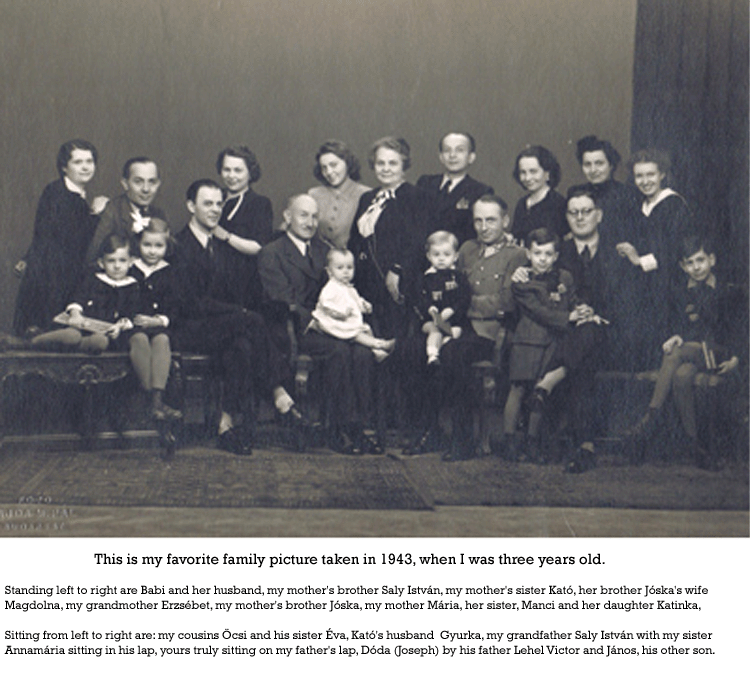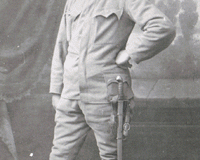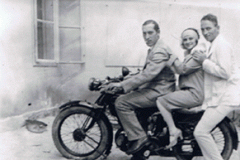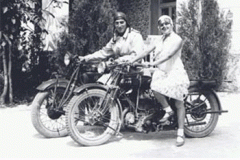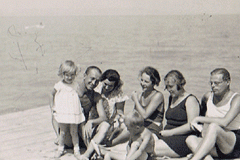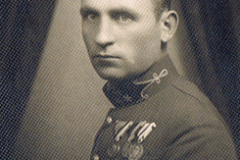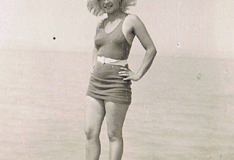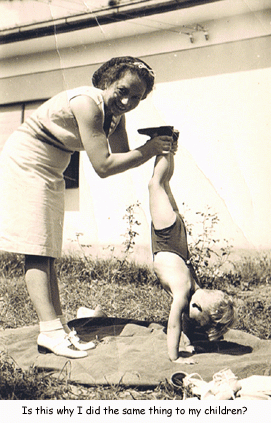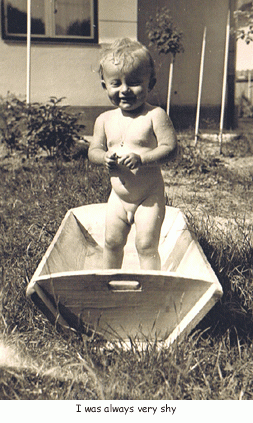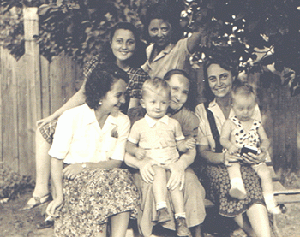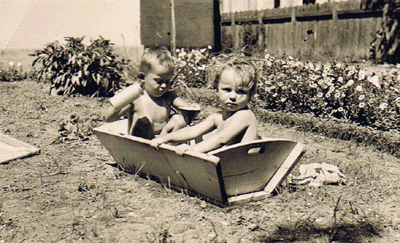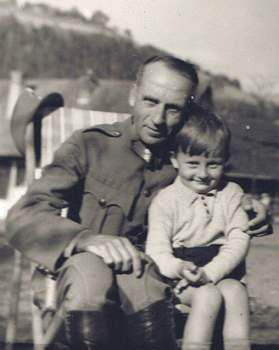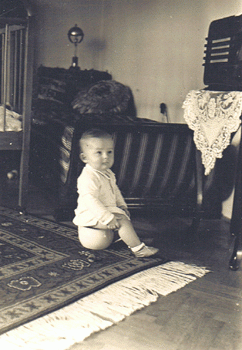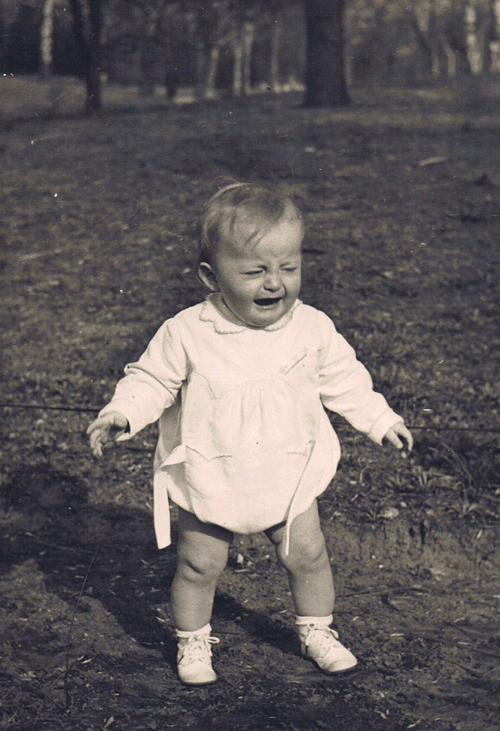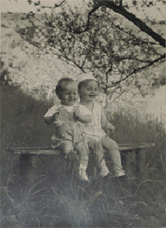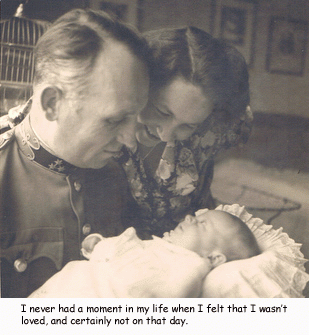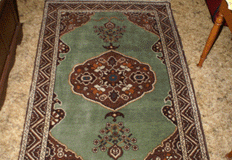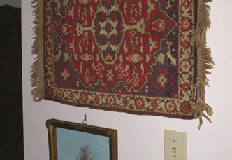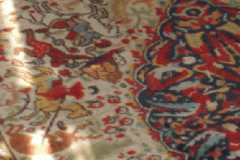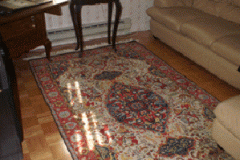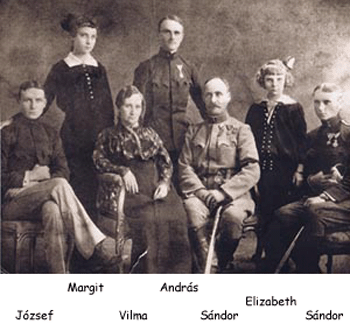
I was born and bred in Hungary, which is not in the Pacific (more on that later) but in Eastern Europe.
My father, József, was a career soldier in the Hungarian Army, as were his two brothers and their father, Sándor before them. My father enlisted in the army when he was only 16, so he could fight in World War I. He was born on July 4th, 1898, and the picture on the next page was taken in 1919, which made him a young 21. He is on the left and was the youngest of five children, with older sister Margit (Mimi), oldest brother András, sister Elizabeth and brother Sándor. My father attended and completed close to a dozen extracurricular courses. His interests spanned the horizon, including diverse activities, such as operating many farm machinery and making dentures. He was a certified dental technician. He has always been interested in photography and it was from him that I inherited my own life-long love affair with this hobby.
My father and his best friend Andrasofszky Kálmán had many adventures before they met my mother. The two of them rode motorcycles all over Europe. My father rode an AJS, later an Indian. Remember that riding a motorcycle in those days was much different than it is today. Virtually all the roads were dirt and gravel and during inclement weather mud was everywhere. Riders wore long overcoats; much like the dusters the cowboys wore in this country and knee-length boots and gauntlets to protect themselves. You also had to be a pretty good mechanic to fix the problems resulting in frequent breakdowns. I still have my father’s leather skull-cap he wore in those days. It has flaps that open for the ears. A few years ago, I attended a motorcycle rally in New Hampshire, a state in which there is no-helmet law, and I wore it for a while, hoping he’d see me.
The two friends were touring around Lake Balaton, a very popular Hungarian tourist location, when they stopped at the house my mother and grandmother were vacationing. My mother was 17 and my father 28. This was their first meeting. Things were very formal back then and they had to be formally introduced before they could talk at their first meeting. It was not love at first sight. My mother said she fell in love with him when they met the second time and he introduced himself again, as though he didn’t remember her from the first time. Shortly thereafter they fell in love and when they finally married, ten long years later, he was her first and she was his.
A career officer in the pre-war army was one of stature and officers were expected to live up to their station. They were to sit in the back when attending movie theaters and in the front when viewing plays and operas, for those were the most expensive tickets. Officers and their families lived in circumstances befitting an officer, entertaining often, opening their homes for informal inspections by higher-ranking officers.
Remember, that these days the family of the bride had to provide a dowery, whose value was determined by the Army. My mother’s father was not a rich man, although both of his sons had completed their college education. My parents were engaged to each other for almost eight years, while they saved their money to add to the dowery. Finally, all was in order, and they married in 1936. My mother’s uncle, a high-ranking bishop in Hungary, married the two of them.
Click on image to see description.
The Wedding in 1936!

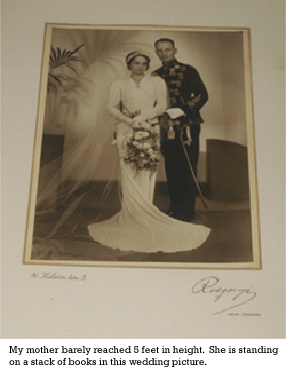
One of the wedding presents they received was a painting, now hanging on our wall in America. It is a self-portrait of Szabó Vladimir (1905 – 1991), a Hungarian painter. I am guessing he painted this early on during his career because he looks hungry and emaciated. As a side-note on the picture: I brought it out of Hungary rolled up in a suitcase. At that time Mary worked with a man, whose father was an Italian immigrant named Girard Morini, an expert restorer of paintings. Many of the paintings hanging in the White House had been restored by him in the seventies. The restoration of a painting is a painstaking process, as it is done a square inch at a time, using different types of solvents to remove the years of dirt, smoke and grime, without removing any of the paint. So, this artiste was humbly commissioned to mount, restore and frame this and two more of our paintings. This one he mounted on slate, as it was rather fragile. We have not had any problems since. According to my mother, the painting is by Szabó Vladimir and it is a self-portrait.
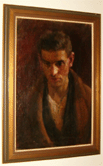
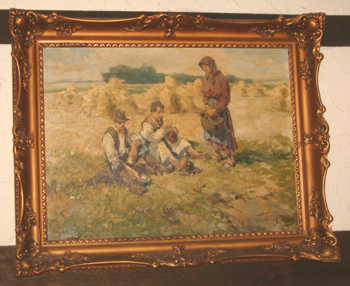
The second painting he repaired and restored for us is the one with the peasants taking a break from working in the fields. It now hangs over our mantle in the living room. It is a rather large painting, so a little creativity was needed t bring this one out of Hungary. We took the painting out and rolled it up and then my father and I wrapped the frame in newspaper and covered it with plastic and string and I just hoisted it up on my shoulder and carried it on the plane with me.
A Son Is Born
Two sons were born but both died as babies and then I came along in 1940. A year later, much to my mother’s delight, my sister, Annamária was born. We were living in the city of Kolozsvár (now Cluj) in Erdély (Transylvania), an area, which is in Romania now. Our house was surrounded by fruit orchards and was rather large. We had a female nanny. There was a soldier, who cut firewood. Another woman did the laundry and ironing. Another soldier was my father’s chauffeur. My father was home a lot and he was an avid and excellent photographer, so I ended up with more pictures of me than anyone I know. I have pictures of me smiling, frowning, crying, laughing, and sleeping ad nauseum.
Our silverware was silver and we used Zsolnay bone china on which to serve and to eat our food. A service for 12 settings of Zsolnay china dinnerware was used often and for but a few pieces it is still in-tact and beautiful after all these years. BTW: Hungary has two famous makers of porcelain: Herend and Zsolnay. Even though the “herendi” china is more popular, I prefer the Zsolnay. Our dinnerware to me is much more elegant and the pieces are almost translucent.
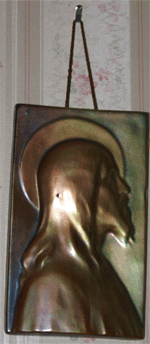
The famous cathedral of St. Matthias (Mátyás) in Budapest has a tiled roof manufactured by the Zsolnay factory from pyrogranite. It is very ornamental but at the same time it resists frost and acid, making it very durable. The roof of the Parliament building across the river sports the same type of colorful tiles on its roof. Zsolnay is also famous for a secret process called eosin, which transforms porcelain to possess a look of iridescent metal. I have an example of this – a small relief of Christ – hanging on the wall in the Hungarian room, the room that contains pictures of a lot of my relatives.
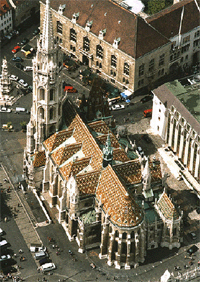
As the years went on my father was away a lot of the time fighting on the front, but my mother was always at my side. When he left for the front, he told me that now that he was gone, I was the man of the house. According to my mother that was the day I reached manhood, transforming me overnight. Once when my father came home after being away for a few weeks, he sported hair that had turned pure white. While he was away, his chauffeur was killed in his car which had 38 bullet holes in it, received while they were both in it.
A story I’ll share with you from this period of my life has to do with a man who came walking by the front of our house. My sister and I happened to be playing close to the fence that surrounded the house. The man asked me if I would trade my gold neck chain for a piece of fruit. I agreed and even went closer to the fence so he could take it off my neck. How dumb could I get? Remember the fruit orchard in the back yard? My business sense hasn’t improved a whole lot since then.
There were parties at the house pretty much every weekend. My mother has always been a wonderful conversationalist and was very outgoing (and outspoken) and was loved by all. Several tables were set up for playing bridge and lots of alcohol and nicotine was consumed. Nobody ever drank excessively and no children were harmed during these weekends. As this is the twenty-first century and we ARE in America I thought I’d get that disclaimer out of the way. Once – according to my mother – I confronted her during a week-end party and wanted to know how she could be so carefree as to entertain knowing full well that my father was away at the front. I could act very indignant even during my early years of childhood.
My father was very much loved and respected by his soldiers. A few were very talented artists who gave him some of their creations. My parents loved and proudly displayed these items in their apartment and we have them displayed in our home.
My mother always kept a meticulous house all her life. Once we moved to Budapest I’ve seen her on her knees waxing and brushing the parquet floors. Of course, the polishing of the floors had to be performed WITH THE GRAIN, which meant changing positions multiple times for each square foot of flooring. I’ve done a fair share of that myself growing up!
It was a difficult task to pick pictures from the seemingly HUNDREDS my father took of us.
Here is a slide show of many of them. Click to view at you own pace.
Combing the fringes on all the oriental rugs before the company’s arrival was another ritual. Most of the rugs in the apartment were woven by my parents and maternal grandparents before I was born. I cherish each and every one of these and take pride in displaying them in my house to this day.
My mother was quite proud of the house and its contents. It wasn’t long after moving in that every room was furnished. It was from this house that all the doilies we have now came from. There were multiple copies of every imaginable size and shape. A lot of them were lost in the war and quite a few to my divorce but, as they say, that’s another cup of coffee.
One day my mother greeted my father excitedly and told him that she went into town and saw an advertisement in a doorway of someone selling an oriental carpet. She rang the doorbell to inquire about it. When the man showed her the rug she fell in love with it. It was huge but she already had a place in mind for it in the house. However when she asked the price, it turned out to be so expensive that she had nowhere the amount in her savings, so she brokenheartedly thanked the man and went home. The next day the man showed up at our house and asked my mother how much she thought she could give him for the carpet. She only had a little more than half of what he was asking. The man told her that he could tell that she loved the carpet but wanted to see what kind of home it would have and once he saw that it was going to a good home, he let her have it for the amount she had saved. That oriental carpet is in our apartment in Budapest right now and my mother had taken care of it all those years, just like its previous owner knew she would.
So long as we’re on the subject of rugs, I want to tell you about a hobby my family had even before I was born. My parents had a loom and my grandparents had one as well, with which they wove rugs. I envision it like working on a jigsaw puzzle, family-style. It is something Mary and I have done many times in the past, especially when the kids were small: We would start a puzzle and sit around the table containing the puzzle and look for a piece to put in its place. When it was time for bed, the kids would leave us and the adults would continue the puzzle. The next day after school Mary and the kids would continue and I would pitch in when I came home from work.
So, it went with my family members all those years ago: My parents and my grandparents on both sides toiled on these rugs and the results were oriental-quality, beautiful rugs of all sizes, from a couple of individual prayer rugs for my brother Peter and me, to several room-sized ones. Once there was a friendly wager made by my father that he would finish his rug (the red one pictured here) before the others finished theirs. My father won and he drew and painted a picture of a pipe (see picture on left), saying that he “smoked” them in the competition. We recently had the picture of the pipe framed and is hanging in our living room.
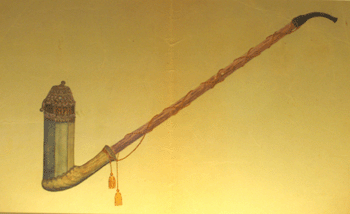

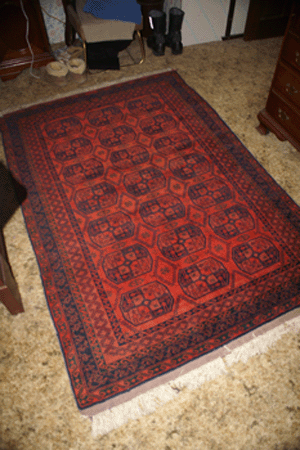
These rugs have weathered the Second World War, the countless beatings by every member of the family with a special tool designed just for that purpose (we didn’t have a vacuum cleaner for many years). The rugs would be taken down to the courtyard and hung over a wooden structure and beat to death. Later, when the energy level dropped due to aging, they were draped over the railing in front of the apartment’s front door and a brush was used to clean them. Later yet the rotating brushes of many vacuum cleaners beat the dust out of them. They were subjected to the constant dust, ever-present in the apartments in Budapest due to ill-fitting doors and windows, not to mention my numerous friends and my brother’s, some of whom were wearing ice skates walking all over the floors and rugs. My brother got the biggest punishment of his life over that incident, by the way.
The pictures above attest to the ruggedness of these wonderful rugs, now proudly displayed in our home. It was never our custom to take off our shoes in the apartment, but we always did make sure our shoes were clean or cleaned after entering the apartment. I think the big difference between then and now is the fact the sneakers were only worn while playing sports, never inside living quarters. When you suddenly changed direction while walking on a rug, your leather sole slipped and didn’t grab the rug like sneakers. Are you listening, Jake?
As a side-note I will mention that all of these rugs and two others not pictured were rolled up, stuffed into a suitcase and hand-carried to their final destination to our home. Rules by international airlines limited your check-in luggage to 20 kg. or 44 pounds, so you can imagine how many trips had to be made to carry all this home.
Click on image to see description.

We turned one of the four bedrooms into a sort of a memorial to my European upbringing. The pictures chronicle my family and my past, all brought over from my parents’ apartment in Budapest.
Our house is also very much our home and I feel especially “at home” in this room, close to my family with whom I grew up.
Exceptions, of course, are the TV and surround system. The three key-wound clocks on top of the secretary were all presents from Mary.


The “Hungarian room” contains other artifacts from my past; all things I left behind in 1956.
The table with the curved legs and the kerosene lamp electrified with the red shade, left behind by the Lehels when they emigrated to England, all resided in the apartment in Budapest.
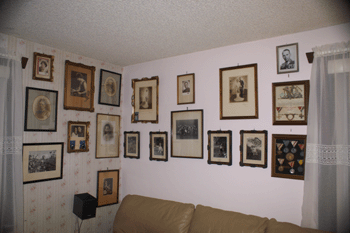

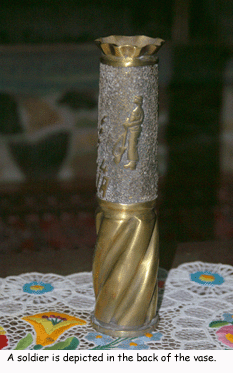
Galicia, an area that is now part of Poland, is where my father and his soldiers were when these artillery shells were so masterfully crafted. The exact method used to accomplish this is not known to me and I would love to know.One of the soldier’s task was to find out my mother’s nickname, so they could use it on the shell below. The rest of them stayed up most of the night to make these pieces of unique art called “trench art”. I recently learned this name when Mary and I visited my cousin George and his wife Ingeborg and they took us to an aerospace museum ouside of Washington, DC. There were some samples of this art in that museum.


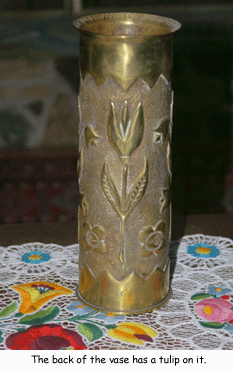
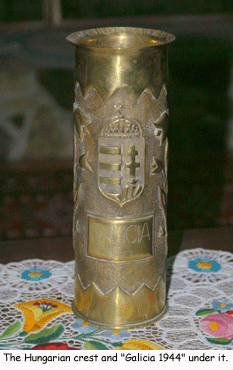

Another soldier, a blacksmith, whose hands were reputedly twice the size of my father’s, created this keepsake from a real egg. It occupies a special place in our hutch today.

